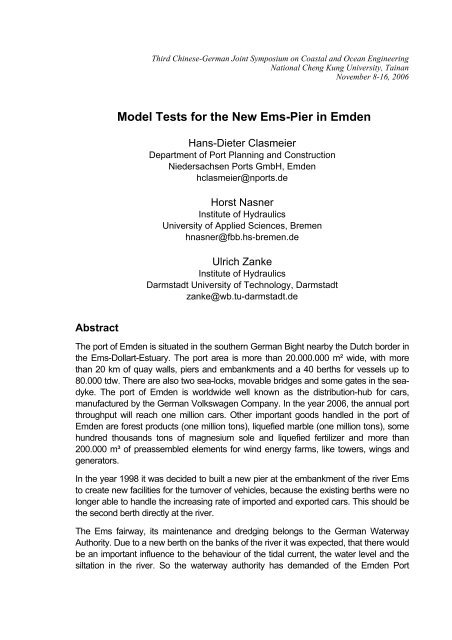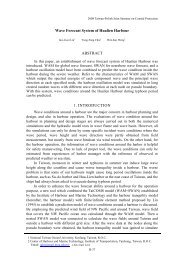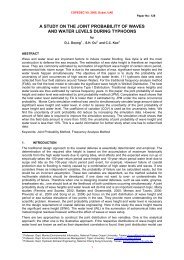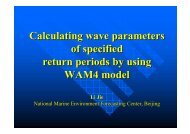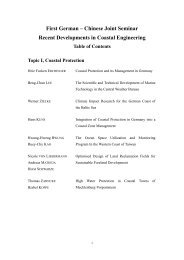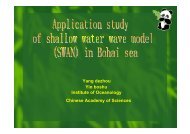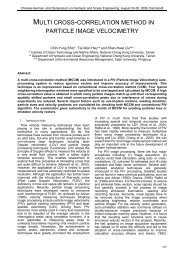Model Tests for the New Ems-Pier in Emden
Model Tests for the New Ems-Pier in Emden
Model Tests for the New Ems-Pier in Emden
Create successful ePaper yourself
Turn your PDF publications into a flip-book with our unique Google optimized e-Paper software.
Abstract<br />
Third Ch<strong>in</strong>ese-German Jo<strong>in</strong>t Symposium on Coastal and Ocean Eng<strong>in</strong>eer<strong>in</strong>g<br />
National Cheng Kung University, Ta<strong>in</strong>an<br />
November 8-16, 2006<br />
<strong>Model</strong> <strong>Tests</strong> <strong>for</strong> <strong>the</strong> <strong>New</strong> <strong>Ems</strong>-<strong>Pier</strong> <strong>in</strong> <strong>Emden</strong><br />
Hans-Dieter Clasmeier<br />
Department of Port Plann<strong>in</strong>g and Construction<br />
Niedersachsen Ports GmbH, <strong>Emden</strong><br />
hclasmeier@nports.de<br />
Horst Nasner<br />
Institute of Hydraulics<br />
University of Applied Sciences, Bremen<br />
hnasner@fbb.hs-bremen.de<br />
Ulrich Zanke<br />
Institute of Hydraulics<br />
Darmstadt University of Technology, Darmstadt<br />
zanke@wb.tu-darmstadt.de<br />
The port of <strong>Emden</strong> is situated <strong>in</strong> <strong>the</strong> sou<strong>the</strong>rn German Bight nearby <strong>the</strong> Dutch border <strong>in</strong><br />
<strong>the</strong> <strong>Ems</strong>-Dollart-Estuary. The port area is more than 20.000.000 m² wide, with more<br />
than 20 km of quay walls, piers and embankments and a 40 berths <strong>for</strong> vessels up to<br />
80.000 tdw. There are also two sea-locks, movable bridges and some gates <strong>in</strong> <strong>the</strong> seadyke.<br />
The port of <strong>Emden</strong> is worldwide well known as <strong>the</strong> distribution-hub <strong>for</strong> cars,<br />
manufactured by <strong>the</strong> German Volkswagen Company. In <strong>the</strong> year 2006, <strong>the</strong> annual port<br />
throughput will reach one million cars. O<strong>the</strong>r important goods handled <strong>in</strong> <strong>the</strong> port of<br />
<strong>Emden</strong> are <strong>for</strong>est products (one million tons), liquefied marble (one million tons), some<br />
hundred thousands tons of magnesium sole and liquefied fertilizer and more than<br />
200.000 m³ of preassembled elements <strong>for</strong> w<strong>in</strong>d energy farms, like towers, w<strong>in</strong>gs and<br />
generators.<br />
In <strong>the</strong> year 1998 it was decided to built a new pier at <strong>the</strong> embankment of <strong>the</strong> river <strong>Ems</strong><br />
to create new facilities <strong>for</strong> <strong>the</strong> turnover of vehicles, because <strong>the</strong> exist<strong>in</strong>g berths were no<br />
longer able to handle <strong>the</strong> <strong>in</strong>creas<strong>in</strong>g rate of imported and exported cars. This should be<br />
<strong>the</strong> second berth directly at <strong>the</strong> river.<br />
The <strong>Ems</strong> fairway, its ma<strong>in</strong>tenance and dredg<strong>in</strong>g belongs to <strong>the</strong> German Waterway<br />
Authority. Due to a new berth on <strong>the</strong> banks of <strong>the</strong> river it was expected, that <strong>the</strong>re would<br />
be an important <strong>in</strong>fluence to <strong>the</strong> behaviour of <strong>the</strong> tidal current, <strong>the</strong> water level and <strong>the</strong><br />
siltation <strong>in</strong> <strong>the</strong> river. So <strong>the</strong> waterway authority has demanded of <strong>the</strong> <strong>Emden</strong> Port
Authority (EPA) to built a hydro morphological model of <strong>the</strong> <strong>Ems</strong>-Estuary and to make<br />
tests with different layout proposals of a new berth.<br />
This paper will deal with:<br />
� Port plann<strong>in</strong>g and construction<br />
∘ <strong>the</strong> future port development at <strong>the</strong> <strong>Ems</strong> embankment<br />
∘ <strong>the</strong> first discussion of <strong>the</strong> berth-layout,<br />
∘ <strong>the</strong> construction of <strong>the</strong> pier (open pier, sheet-pile pier or comb<strong>in</strong>ed solution)<br />
� Demands to port plann<strong>in</strong>g (approval procedure)<br />
� <strong>Model</strong> tests <strong>in</strong> <strong>the</strong> hydro-morphological model<br />
∘ model borders<br />
∘ data <strong>in</strong>put of <strong>the</strong> exist<strong>in</strong>g situation (bottom, tidal current and volume)<br />
∘ description of <strong>the</strong> model tests and <strong>the</strong> results<br />
� Demands to <strong>the</strong> execution works<br />
� Pile driv<strong>in</strong>g and dredg<strong>in</strong>g <strong>in</strong> <strong>the</strong> years 2002 to 2005<br />
� Monitor<strong>in</strong>g be<strong>for</strong>e, dur<strong>in</strong>g and after <strong>the</strong> execution of <strong>the</strong> dredg<strong>in</strong>g works<br />
� Comparison of <strong>the</strong> monitor<strong>in</strong>g results with <strong>the</strong> <strong>for</strong>ecast of <strong>the</strong> model test<br />
The result of <strong>the</strong> monitor<strong>in</strong>g was, that <strong>the</strong> basis-data of <strong>the</strong> model-tests were nearly <strong>the</strong><br />
same, like <strong>the</strong> reality will show it after build<strong>in</strong>g <strong>the</strong> <strong>Ems</strong>-<strong>Pier</strong>. <strong>Model</strong>-tests, if <strong>the</strong>y will be<br />
carried out by high accuracy and a good data-<strong>in</strong>put are able to give a real <strong>in</strong>troduction<br />
of behaviour chang<strong>in</strong>g <strong>in</strong> a tidal river due to any k<strong>in</strong>d of river tra<strong>in</strong><strong>in</strong>g and port build<strong>in</strong>g.<br />
1 Introduction<br />
The port of <strong>Emden</strong> is situated <strong>in</strong> <strong>the</strong> sou<strong>the</strong>rn German Bight nearby <strong>the</strong> Dutch border<br />
<strong>in</strong> <strong>the</strong> <strong>Ems</strong>-Dollart-estuary (Figure 1 a-b).<br />
Fig. 1 a) German Bight b) East Frisia
Fig. 2 a) <strong>Emden</strong> - Inner port b) <strong>Emden</strong> - Outer port<br />
The landscape is characterized by <strong>the</strong> wadden-sea and low flatlands, partially<br />
under <strong>the</strong> mean sea-level. Its name is East Frisia with several small fishery<br />
harbours and <strong>the</strong> ma<strong>in</strong> port of <strong>Emden</strong>. The port area is more than 20.000.000 m²<br />
wide, with more than 20 km of quay walls, piers and embankments and nearly 40<br />
berths <strong>for</strong> vessels up to 80.000 tdw. There are also two sea-locks, movable<br />
bridges and some gates <strong>in</strong> <strong>the</strong> sea-dyke (Figure 2). The port of <strong>Emden</strong> is known<br />
worldwide as <strong>the</strong> distribution hub <strong>for</strong> cars, manufactured by <strong>the</strong> German<br />
Volkswagen Company. In <strong>the</strong> year 2006, <strong>the</strong> annual port throughput will reach one<br />
million cars.<br />
O<strong>the</strong>r important goods be<strong>in</strong>g handled <strong>in</strong> <strong>the</strong> port of <strong>Emden</strong> are <strong>for</strong>est products (1<br />
million tons), liquefied marble (1 million tons), some hundred thousands tons of<br />
sole and fertilizer and more than 200.000 m³ of w<strong>in</strong>d energy parts, like towers,<br />
propellers and generators (see figure 3). The Thyssen shipyard is ano<strong>the</strong>r<br />
important customer of <strong>Emden</strong> Port.<br />
6,00<br />
5,00<br />
4,00<br />
3,00<br />
2,00<br />
1,00<br />
0,00<br />
1991 1992 1993 1994 1995 1996 1997 1998 1999 2000 2001 2002 2003 2004<br />
Inland Vessel Traffic<br />
Cars<br />
not specified<br />
Steel Products<br />
Conta<strong>in</strong>er<br />
Build<strong>in</strong>g Material<br />
Forest Poroducrs<br />
Liquid Marble<br />
Gra<strong>in</strong><br />
Oil<br />
Island Traffic<br />
Ore and Coal<br />
Fig. 3 Throughput of goods handled <strong>in</strong> <strong>the</strong> port of <strong>Emden</strong> <strong>in</strong> millions. tons
Fig. 4a-e The development of <strong>the</strong> <strong>Ems</strong> Dollart-estuary and <strong>Emden</strong> Port<br />
The history of <strong>Emden</strong> Port is more than 1.000 years old. In <strong>for</strong>mer times <strong>the</strong> port<br />
was situated at <strong>the</strong> outer bend of <strong>the</strong> river <strong>Ems</strong>, where strong currents were able<br />
to keep free <strong>the</strong> port from sedimentation. Several very high and destructive storm<br />
surges had built <strong>in</strong> <strong>the</strong> ages between <strong>the</strong> 12 th and 16 th century <strong>the</strong> Dollart estuary<br />
and <strong>the</strong> <strong>Ems</strong>-River got a new bed far off <strong>the</strong> old port layout. The people had tried<br />
to br<strong>in</strong>g back <strong>the</strong> <strong>Ems</strong>-River to <strong>the</strong> <strong>for</strong>mer port, but this so called landmark<br />
Nesserlander Höft has had only an existence of less than 100 years. In <strong>the</strong> early<br />
ages of <strong>the</strong> 19 th century <strong>the</strong> port authority has decided to built a new canal<br />
between <strong>the</strong> new settled <strong>Ems</strong>-River, nearly 3 km away from <strong>the</strong> old port. This<br />
new canal was closed by a lock aga<strong>in</strong>st <strong>the</strong> tidal conditions of <strong>the</strong> <strong>Ems</strong> (Figure<br />
4a-e). Besides <strong>the</strong> new canal, called <strong>the</strong> new <strong>Emden</strong> Fairway, several port <strong>in</strong>fra-<br />
and superstructure elements were <strong>in</strong>stalled, <strong>the</strong> layout of <strong>Emden</strong> port has gotten<br />
his today’s architecture.<br />
The early 20 th century needed a lot of coal and ore <strong>in</strong> <strong>the</strong> heart of Europe. The<br />
steel production was on an <strong>in</strong>creas<strong>in</strong>g trend. The import of ore was of high<br />
importance. By a decision of <strong>the</strong> German emperor Wilhelm <strong>Emden</strong> was made as<br />
<strong>the</strong> ma<strong>in</strong> port <strong>for</strong> <strong>the</strong> Ruhr District, where <strong>the</strong> most important German and<br />
European steel manufacturers has had <strong>the</strong>ir factories.<br />
In <strong>the</strong> late 70 th of <strong>the</strong> last century <strong>the</strong> port of <strong>Emden</strong> has had an annual ports<br />
turnover of more than 16 mill. tons, but <strong>the</strong> <strong>in</strong>creas<strong>in</strong>g growth of <strong>the</strong> <strong>in</strong>ternational<br />
bulk carrier fleet had given to <strong>Emden</strong> Port <strong>the</strong> signal, to deepen <strong>the</strong> <strong>Ems</strong>-River or<br />
to loose its importance as an ore-hub port to Rotterdam and Antwerp. But only<br />
deepen<strong>in</strong>g <strong>the</strong> <strong>Ems</strong>-River hasn’t had any economical value aga<strong>in</strong>st <strong>the</strong> benefit to<br />
take on <strong>the</strong> very cheap load of ore. The so called Dollart-Dock Project was created
Fig.5 a) <strong>Ems</strong>-Dollart estuary b) Dollart Dock-Project with <strong>Ems</strong><br />
bypass<br />
(Figure 5). The <strong>Ems</strong>-River should be bypassed through <strong>the</strong> Dollart estuary to<br />
m<strong>in</strong>imize dredg<strong>in</strong>g cost and a huge new port area should be able <strong>for</strong> <strong>the</strong> settlement<br />
of several <strong>in</strong>dustrial factories. But <strong>the</strong> project-costs <strong>in</strong>creased while <strong>the</strong> <strong>in</strong>terest of<br />
companies to settle <strong>in</strong> <strong>Emden</strong> where decreas<strong>in</strong>g. In 1989 <strong>the</strong> Dollart-Dock-Project<br />
was f<strong>in</strong>ally cancelled. That was <strong>the</strong> beg<strong>in</strong>n<strong>in</strong>g of a process to restructure <strong>the</strong> port of<br />
<strong>Emden</strong> from an ore and coal port to a modern multi purpose <strong>in</strong>dustrial harbour.<br />
At this time <strong>in</strong> <strong>the</strong> early 90 th <strong>the</strong> <strong>Ems</strong>-River has had a depth of 8,50 m at low tide. To<br />
develop<strong>in</strong>g <strong>the</strong> port <strong>for</strong> those vessels, be<strong>in</strong>g able to reach it under <strong>the</strong> given<br />
circumstances was <strong>the</strong> huge task to <strong>the</strong> port plann<strong>in</strong>g division.<br />
2 The International Car Producers Need <strong>the</strong> Hub Port <strong>Emden</strong><br />
In <strong>the</strong> early 1960 th <strong>the</strong> German Government has decided toge<strong>the</strong>r with <strong>the</strong><br />
Volkswagen Company to built assembl<strong>in</strong>g facilities <strong>in</strong> <strong>the</strong> neighbourhood of a<br />
harbour, to <strong>in</strong>crease German export of Volkswagen-Cars especially <strong>in</strong>to <strong>the</strong> USA.<br />
<strong>Emden</strong> was <strong>the</strong> w<strong>in</strong>ner <strong>in</strong> this comparision. Always <strong>in</strong> <strong>the</strong> early 70 th <strong>Emden</strong> Port has<br />
had an export rate <strong>for</strong> cars of more than 500.000 pieces/p.a.<br />
The up and down of car bus<strong>in</strong>ess has brought <strong>in</strong> <strong>the</strong> late 90 th <strong>the</strong> decision of <strong>the</strong><br />
Volkswagen trust (<strong>in</strong>cl. AUDI, SEAT and Skoda) to develop <strong>the</strong> port of <strong>Emden</strong> as <strong>the</strong><br />
Volkswagen hub port worldwide. The import and export of Volkswagen cars should<br />
be done via <strong>the</strong> quay walls of <strong>Emden</strong> Port. But <strong>the</strong>re<strong>for</strong>e <strong>the</strong> exist<strong>in</strong>g port facilities<br />
would not be able to handle <strong>the</strong> <strong>for</strong>ecasted number of 1,0 mill. cars/p.a. and more.<br />
Via <strong>the</strong> <strong>for</strong>mer fully developed system <strong>in</strong> <strong>the</strong> port not more than 250.000 cars/a to<br />
western Europe via Term<strong>in</strong>al I (2 berths) <strong>in</strong> <strong>the</strong> Inner Port and ano<strong>the</strong>r 500.000<br />
cars/p.a. via <strong>the</strong> three berths at <strong>the</strong> Outer port to overseas can be handled (Figure 6).<br />
There<strong>for</strong>e <strong>in</strong> <strong>the</strong> year 1998 it was decided to built a new pier at <strong>the</strong> embankment of<br />
<strong>the</strong> river <strong>Ems</strong> to create new facilities <strong>for</strong> <strong>the</strong> turnover of vehicles. This should be <strong>the</strong><br />
second berth directly at <strong>the</strong> river. But <strong>the</strong> <strong>Ems</strong> fairway, its ma<strong>in</strong>tenance and dredg<strong>in</strong>g<br />
belongs to <strong>the</strong> German waterway authority (WSD). Due to a new berth at <strong>the</strong> banks of<br />
<strong>the</strong> river it was suspected, that <strong>the</strong>re would be an important <strong>in</strong>fluence to <strong>the</strong> behaviour<br />
of <strong>the</strong> tidal current, <strong>the</strong> water level and <strong>the</strong> siltation <strong>in</strong> <strong>the</strong> river. So <strong>the</strong> waterway<br />
authority demanded of <strong>the</strong> <strong>Emden</strong> Port Authority (EPA) to built a morpho-dynamical<br />
model of <strong>the</strong> <strong>Ems</strong> and to make model-tests with different solutions of a new berth.
Fig. 6 Handl<strong>in</strong>g of cars and car-carrier <strong>in</strong> <strong>Emden</strong> Port<br />
3 Plann<strong>in</strong>g of <strong>the</strong> <strong>New</strong> <strong>Ems</strong>-<strong>Pier</strong><br />
3-1 Port Plann<strong>in</strong>g<br />
There was <strong>the</strong> demand to take-on car-carrier up to a length of 220 m, a beam of<br />
32 m and a draught of 8,50 m at a new berth. This vessels are able to transport up<br />
to 8.000 car-units (a car unit equals 6,34 m²). The pier-level should be 2.50 m over<br />
<strong>the</strong> mean high water level (MHW). Because <strong>the</strong>re is <strong>the</strong> possibility to arrive at<br />
<strong>Emden</strong> Port over high tide with a draught of nearly 11 m <strong>the</strong> nautical depth of <strong>the</strong><br />
new berth was fixed on 14,50 m under MHW and so <strong>the</strong> reta<strong>in</strong><strong>in</strong>g height of <strong>the</strong> pier<br />
would be 17,00 m.<br />
The length of <strong>the</strong> pier deck was asked to be 250 m, but on both ends a 50 m long<br />
berth<strong>in</strong>g walkway <strong>in</strong>clud<strong>in</strong>g several bollards and quick release hooks should be<strong>in</strong>g<br />
situated. At <strong>the</strong> seaside end of <strong>the</strong> new berth should be some <strong>in</strong>frastructure like a<br />
movable bridge and some dolph<strong>in</strong>s to allow smaller car carrier to take over cars<br />
and Ro-Ro trailer via any k<strong>in</strong>d of stern ramp.<br />
3-2 Future Port Development on <strong>the</strong> <strong>Ems</strong> – River Embankment<br />
With a view <strong>in</strong> <strong>the</strong> future it was found a place <strong>for</strong> <strong>the</strong> new berth <strong>in</strong> a distance from<br />
500 m western <strong>the</strong> exist<strong>in</strong>g <strong>Ems</strong>-Quay. So it will be possible to enlarge <strong>the</strong> <strong>Ems</strong>-<br />
Quay by 250 m and to enlarge <strong>the</strong> new <strong>Ems</strong>-<strong>Pier</strong> also by 250 m, but <strong>in</strong> eastern<br />
direction. The total length of <strong>the</strong> <strong>Ems</strong>-River embankment quays than could be<br />
1.200 m with 5 berths <strong>for</strong> ocean-go<strong>in</strong>g vessels up to 220 m length (figure 7).
Fig. 7 Planned berth development along <strong>the</strong> <strong>Ems</strong>-River<br />
3-3 The construction of <strong>the</strong> <strong>Ems</strong>-<strong>Pier</strong><br />
To built a quay wall with a reta<strong>in</strong><strong>in</strong>g height of 17,00 m (plus 2 m safety distance<br />
aga<strong>in</strong>st scour and dredg<strong>in</strong>g tolerance) needs ei<strong>the</strong>r a very strong and heavy steel<br />
sheet pile solution or an open pile construction with a high pier deck. A<br />
comb<strong>in</strong>ation of both is possible. F<strong>in</strong>d<strong>in</strong>g <strong>the</strong> right solution is a matter of economy<br />
at one side but also a question of hydrology and morphology. <strong>Model</strong> tests would<br />
be necessary to give an answer to <strong>the</strong> second question.<br />
At first was found out, that <strong>the</strong> pure steel sheet pile construction doesn’t give a<br />
practical adequate construction, because waves would be reflected and <strong>the</strong> water<br />
would swamp over <strong>the</strong> pier deck. An open construction would avoid this and so<br />
two different pier layouts were detailed:<br />
� <strong>Pier</strong> plat<strong>for</strong>m with a concrete deck, 30 m wide, with 7 rows of piles and a small<br />
steel sheet pile wall <strong>in</strong> <strong>the</strong> landside 7 th row. An open non armoured<br />
embankment was under <strong>the</strong> pier plat<strong>for</strong>m. (Figure 8 a).<br />
Fig. 8 a) <strong>Pier</strong> plat<strong>for</strong>m, 30 m wide b) plat<strong>for</strong>m with 2 sheet piles and<br />
amnbankment
Concrete deck<br />
Steel<br />
wall<br />
sheet pile<br />
Tubular steel pile<br />
Concrete pile<br />
Steel anchor pile<br />
Fig. 8 c) Section of <strong>the</strong> <strong>Ems</strong>-<strong>Pier</strong>, like f<strong>in</strong>ally executed<br />
� <strong>Pier</strong> plat<strong>for</strong>m like above, but with two rows of sheet piles and an embankment<br />
under <strong>the</strong> pier (This alternative was <strong>in</strong>vestigated <strong>in</strong> <strong>the</strong> model, but has later<br />
been cancelled (Figure 8 b).<br />
� F<strong>in</strong>ally a pier plat<strong>for</strong>m with a concrete deck, 15 m wide, with 3 rows of piles<br />
was realized. Heavy steel sheet pile wall <strong>in</strong> <strong>the</strong> middle row. Open space<br />
without embankment waterside of <strong>the</strong> sheet pile wall. (Figure 8 c).<br />
By means of this two quay section solutions <strong>the</strong> model tests had been started<br />
4 <strong>Model</strong> <strong>Tests</strong> <strong>in</strong> <strong>the</strong> Morpho-dynamical <strong>Model</strong><br />
4-1 General<br />
In Germany and <strong>in</strong> <strong>the</strong> European Union <strong>the</strong> plann<strong>in</strong>g of a new harbour or<br />
only a quay wall <strong>in</strong> an exist<strong>in</strong>g harbour requires a very <strong>in</strong>tensive approval<br />
procedure. To shorten this procedure <strong>the</strong> EPA had <strong>in</strong>structed <strong>the</strong> waterway<br />
authority <strong>in</strong> advance about <strong>the</strong> plann<strong>in</strong>g of <strong>the</strong> <strong>Ems</strong>-<strong>Pier</strong>. The demand of<br />
model tests was <strong>the</strong> result (see below). Because <strong>the</strong> hydraulic laboratories of<br />
<strong>the</strong> waterway authority should be <strong>the</strong>ir adviser, it needed a scientific <strong>in</strong>stitute<br />
to make this model tests.<br />
The Institute <strong>for</strong> Hydraulics of <strong>the</strong> Technical University of Darmstadt has well<br />
known <strong>in</strong> practise and experience of morpho-dynamical computer models<br />
and it also has <strong>the</strong> knowledge about <strong>the</strong> tidal conditions <strong>in</strong> <strong>the</strong> <strong>Ems</strong> Dollart<br />
Estuary. Prof. Zanke from Darmstadt was asked to give an expertise about<br />
<strong>the</strong> chang<strong>in</strong>g of <strong>the</strong> river behaviour <strong>in</strong> <strong>the</strong> neighbourhood due to <strong>the</strong> planned<br />
<strong>Ems</strong>-<strong>Pier</strong>
4-2 The Task to <strong>the</strong> Experts<br />
The layout showed that new quay-l<strong>in</strong>e of <strong>the</strong> <strong>Ems</strong>-pier will be nearly 100 m<br />
seaside away today’s high water-l<strong>in</strong>e. This would reduce <strong>the</strong> cross section of <strong>the</strong><br />
<strong>Ems</strong>-River of about 300 m² at one side and it will widen <strong>the</strong> cross section of about<br />
200 m² on <strong>the</strong> o<strong>the</strong>r side, while <strong>the</strong> river would be deepened.<br />
Three ma<strong>in</strong> questions were discussed:<br />
� What is <strong>the</strong> chang<strong>in</strong>g of <strong>the</strong> current situation due to <strong>Ems</strong>-pier <strong>in</strong> <strong>the</strong> near<br />
<strong>Ems</strong>-River?<br />
� Which extension would have this chang<strong>in</strong>g’s?<br />
� What is <strong>the</strong> <strong>in</strong>fluence of <strong>the</strong> <strong>Ems</strong>-pier to <strong>the</strong> sediment-behaviour <strong>in</strong> <strong>the</strong><br />
<strong>Ems</strong>-Fairway?<br />
A satisfactory answer to this questions could be given by <strong>the</strong> follow<strong>in</strong>g means:<br />
� The morphological chang<strong>in</strong>g’s need a morpho-dynamical model with a<br />
separate calculation of <strong>the</strong> sediment load near <strong>the</strong> river-bed and<br />
suspension load <strong>in</strong> <strong>the</strong> water body.<br />
� The sediment load must be partitioned <strong>in</strong> several fractions<br />
� The subsoil below <strong>the</strong> river-bed needs some different layers<br />
This procedure was recommended by <strong>the</strong> scientists and discussed and approved<br />
by <strong>the</strong> port authority and <strong>the</strong> waterway authority.<br />
4-3 Data <strong>Model</strong> and <strong>Model</strong> Borders<br />
Prof Zanke of Darmstadt University has recommended us<strong>in</strong>g an explicit FEMsystem<br />
<strong>for</strong> <strong>the</strong> calculation of currents <strong>in</strong> <strong>the</strong> <strong>Ems</strong>-River and <strong>the</strong> Dollart-estuary. To<br />
avoid 2-delta-x-waves, <strong>the</strong> so called bubble-function should be used <strong>for</strong> a<br />
harmonic solution.<br />
For <strong>the</strong> follow<strong>in</strong>g morpho-dynamical survey was used <strong>the</strong> well-known model<br />
system TIMOR3. This model is able to simulate as well <strong>the</strong> sediment as <strong>the</strong><br />
suspension transport. TIMOR3 is based on a two dimensional FEM model <strong>for</strong><br />
currents. Because <strong>the</strong>re is <strong>the</strong> possibility to built several layers of soil <strong>the</strong> sediment<br />
transport can be given back <strong>in</strong> <strong>the</strong> three-dimensional space. The system can verify<br />
as well soft clay as sand or gravel. Non erosional structures like gro<strong>in</strong>s or jetties<br />
can be considered.<br />
For modell<strong>in</strong>g <strong>the</strong> <strong>Ems</strong>-Dollart-estuary a collective of data, taken by <strong>the</strong> German<br />
waterways authority due to survey<strong>in</strong>g <strong>the</strong> fairway water depth was used. It was<br />
decided to set widen<strong>in</strong>g of <strong>the</strong> estuary to <strong>the</strong> open sea as seaside border and <strong>the</strong><br />
entrance of <strong>the</strong> <strong>Ems</strong>-River <strong>in</strong>to <strong>the</strong> Dollart-bay as <strong>in</strong>land border (Figure 9 a-b).
4-4 Data Input of Today’s Situation (River Bed, Tidal Current and Flow,<br />
Tidal Volume)<br />
The digital topographical model was constructed out of 19.000 knots and<br />
36.000 triangles. The planned <strong>Ems</strong>-<strong>Pier</strong> with its new geometry and <strong>the</strong> new<br />
riverbed level was brought <strong>in</strong>to this model after verify<strong>in</strong>g model data with <strong>the</strong><br />
data measured <strong>in</strong> <strong>the</strong> nature (Figure 10 a-b).<br />
In a second step it was necessary to verify also <strong>the</strong> morphological situation.<br />
Because <strong>the</strong>re was not enough <strong>in</strong><strong>for</strong>mation about <strong>the</strong> sediment composition all<br />
over <strong>the</strong> estuary, a syn<strong>the</strong>tic sediment composition was calculated. The climate<br />
of <strong>the</strong> currents will mix this composition and a characteristic sediment<br />
distribution will be found.<br />
Fig. 9 a) Morphological situation <strong>in</strong> <strong>the</strong> b) FEM grid with model<br />
borders <strong>Ems</strong>-Dollart estuary<br />
Fig..10 a) Morphology nearby <strong>the</strong> <strong>Ems</strong>-<strong>Pier</strong>; b) Plannend morphology with <strong>Ems</strong>-<br />
<strong>Pier</strong>
4-5 Description of <strong>the</strong> model tests and <strong>the</strong> results<br />
At first <strong>the</strong> exist<strong>in</strong>g current situation without <strong>the</strong> <strong>Ems</strong>-<strong>Pier</strong> was tested. Where <strong>the</strong><br />
<strong>Pier</strong> should be built a maximum current of 0,8 m/sec <strong>for</strong> <strong>the</strong> ebb-tide and also <strong>for</strong><br />
<strong>the</strong> flood-tide was found out. Now it was possible to render <strong>the</strong> two geometries of<br />
<strong>the</strong> <strong>Ems</strong>-<strong>Pier</strong> <strong>in</strong>to <strong>the</strong> model. Because <strong>the</strong> <strong>Ems</strong>-<strong>Pier</strong> should be built as an open<br />
system with several piles it needs to give each pile a separate resistance <strong>for</strong> <strong>the</strong><br />
calculation. This was very difficult and <strong>the</strong>re<strong>for</strong>e ano<strong>the</strong>r friction at <strong>the</strong> river bed<br />
was brought <strong>in</strong>to <strong>the</strong> model as a substitute.<br />
The current velocity nearby <strong>the</strong> new pier would be 0,4 to 0,6 m/sec lower than<br />
today. But this chang<strong>in</strong>g was found out only at <strong>the</strong> maximum, compared with <strong>the</strong><br />
exist<strong>in</strong>g situation. To give a practical result, <strong>the</strong> difference of <strong>the</strong> absolute currents<br />
at each po<strong>in</strong>t with or without <strong>Ems</strong>-<strong>Pier</strong> was calculated as shown <strong>in</strong> Figure 11.<br />
Build<strong>in</strong>g an <strong>Ems</strong>-<strong>Pier</strong> will have an <strong>in</strong>fluence to <strong>the</strong> current:<br />
� The new pier demands widen<strong>in</strong>g <strong>the</strong> river <strong>for</strong> <strong>the</strong> vessels and <strong>the</strong>re<strong>for</strong>e<br />
<strong>the</strong> resistance of <strong>the</strong> current will be lower<br />
� But <strong>the</strong> resistance of <strong>the</strong> piles below <strong>the</strong> pier will br<strong>in</strong>g locally more<br />
resistance aga<strong>in</strong>st <strong>the</strong> current<br />
� Both effects will <strong>in</strong>fluence each o<strong>the</strong>r<br />
The effects differ only at some po<strong>in</strong>ts <strong>in</strong> <strong>the</strong> whole plann<strong>in</strong>g area, ma<strong>in</strong>ly directly<br />
nearby <strong>the</strong> pier. There was no essential difference between <strong>the</strong> two proposals.<br />
With this knowledge it was possible to give a one-year <strong>for</strong>ecast <strong>for</strong> sedimentation.<br />
May be deepen<strong>in</strong>g activities <strong>in</strong> front off <strong>the</strong> pier will result <strong>in</strong> a sedimentation<br />
between 50 and 75 cm each year. Figure 12 gives an idea of <strong>the</strong> behaviour at <strong>the</strong><br />
river bed.<br />
Fig. 11 a) Chang<strong>in</strong>g of currents at ebb-tide; b) Chang<strong>in</strong>g of currents at floodtide<br />
(blue colour = <strong>in</strong>creas<strong>in</strong>g, red colour = decreas<strong>in</strong>g)
Fig. 12 Chang<strong>in</strong>g of river bed <strong>in</strong> a period of one year (blue colour =<br />
sedimentation; red colour = erosion)<br />
5 The Formal Approval Procedure <strong>for</strong> <strong>the</strong> <strong>Ems</strong>-<strong>Pier</strong><br />
The results of <strong>the</strong> numerical tests were rendered <strong>in</strong>to <strong>the</strong> <strong>Ems</strong>-<strong>Pier</strong> design and <strong>the</strong><br />
above shown section (fig.8c) was chosen <strong>for</strong> <strong>the</strong> approval procedure. Some<br />
additional tests were made by <strong>the</strong> hydraulic laboratory. But <strong>the</strong> result didn’t differ<br />
from what was found of <strong>the</strong> orig<strong>in</strong>ally model - tests.<br />
5-1 Demands of <strong>the</strong> Waterway Authority to <strong>the</strong> Dredg<strong>in</strong>g Execution<br />
Works<br />
5-1-1 Monitor<strong>in</strong>g Program<br />
It was calculated that <strong>the</strong> cross-section of <strong>the</strong> river-bed due to <strong>the</strong> new <strong>Ems</strong>-<br />
<strong>Pier</strong> will be lessen it by 250 m² at one side and will be widened by less than 400<br />
m² on <strong>the</strong> o<strong>the</strong>r side. To widen it means about 300.000 m³ sand, silt and clay<br />
needs totally to be dredged. It was <strong>for</strong>eseen to do this work by a section cutter<br />
dredger (see fig.13)<br />
Due to <strong>the</strong> clay <strong>in</strong> <strong>the</strong> upper layers and a maximum flood and ebb current with<br />
more than 1,5 m/sec <strong>the</strong> waterways authority was concerned, that too much<br />
particles would be driven off <strong>in</strong>to <strong>the</strong> <strong>Ems</strong> fairway <strong>for</strong> sedimentation <strong>the</strong>re.<br />
There<strong>for</strong>e <strong>the</strong>y have demanded <strong>for</strong> a monitor<strong>in</strong>g program dur<strong>in</strong>g <strong>the</strong> execution of<br />
<strong>the</strong> dredg<strong>in</strong>g works. The port authority has excepted this demand and has given<br />
an order to <strong>the</strong> Hydraulic Institute of <strong>the</strong> University of Applied Science Bremen,<br />
Professor Horst Nasner.
Fig. 13 Cutter section dredger <strong>in</strong> action at <strong>the</strong> new <strong>Ems</strong>-<strong>Pier</strong><br />
5-1-2 Requirements to <strong>the</strong> dredg<strong>in</strong>g works<br />
To m<strong>in</strong>imise <strong>the</strong> effect, that f<strong>in</strong>e dredged material will go <strong>in</strong>to suspension due to<br />
cutter heads activities and will sunk than as sediment <strong>in</strong> <strong>the</strong> fairway it was<br />
<strong>for</strong>bidden to use hopper dredgers with an overflow-system. Only <strong>the</strong> directly way<br />
from a section cutter dredger <strong>in</strong>to <strong>the</strong> float<strong>in</strong>g transport tube and than <strong>in</strong>to <strong>the</strong><br />
nearby disposal area was accepted.<br />
5-2 <strong>Ems</strong>-<strong>Pier</strong> and dredg<strong>in</strong>g works as an impact to <strong>the</strong> environment<br />
Due to <strong>the</strong> <strong>Ems</strong>-<strong>Pier</strong> an area of 250 ha waddenzee banks and low river bed will be<br />
impacted by dredg<strong>in</strong>g works (deepen <strong>the</strong> river) or by <strong>the</strong> pier construction (high up<br />
<strong>the</strong> river bed). A lot of different species will be disturbed, expelled or killed.<br />
There<strong>for</strong>e it needs to f<strong>in</strong>d a substitute. But <strong>the</strong> impact was not all over <strong>the</strong><br />
construction and dredg<strong>in</strong>g works. Only at low tide <strong>the</strong> banks are used especially by<br />
<strong>the</strong> birds and not all times it will be worked. So a very difficult calculation came to<br />
<strong>the</strong> result, that <strong>the</strong> time impact component would reduce <strong>the</strong> area of disturbance<br />
down to 15 ha. Because it was not possible to create a new river bed, a nearby<br />
located today <strong>in</strong>tensive used farm land was chosen to develop it as wetland with<br />
ponds and marshy zones. To substitute 15 ha river bed, it needs a factor of 1,8 to<br />
found <strong>the</strong> total area of <strong>the</strong> substitute.
Fig. 14 a) Pile driv<strong>in</strong>g <strong>for</strong> sheet-pile wall ; b) Element of concrete<br />
deck<br />
6 Execution of <strong>the</strong> <strong>Ems</strong>-<strong>Pier</strong><br />
6-1 Sheet Pile Wall Installation, Pile Driv<strong>in</strong>g and Concrete Deck<br />
Step one <strong>in</strong> execution was to drive <strong>in</strong>to <strong>the</strong> sea-bottom <strong>the</strong> steel sheet-pile of 350<br />
m. Beh<strong>in</strong>d <strong>the</strong> wall nearly 100.000 m³ soft clay was dredged and pumped <strong>in</strong>to a<br />
nearby disposal area. The anchor-piles were driven down and <strong>the</strong> space between<br />
dyke and sheet-pile wall was reclaimed with sand. The second and <strong>the</strong> third row of<br />
piles could be driven down. The concrete deck was built and <strong>the</strong> <strong>for</strong>eseen<br />
reclaim<strong>in</strong>g level was filled up with sand. The surface of <strong>the</strong> new pier was covered<br />
with an asphalt layer. See <strong>in</strong> figure 14 some <strong>in</strong>troduction from pile driv<strong>in</strong>g and<br />
concrete works.<br />
6-2 Dredg<strong>in</strong>g Works<br />
6-2-1 Soil Replacement and Reclamation Works<br />
Very soft clay layers need to be substituted by sand beh<strong>in</strong>d <strong>the</strong> sheet pile wall to<br />
reduce <strong>the</strong> settlement but also to <strong>in</strong>crease <strong>the</strong> resistance <strong>in</strong>to <strong>the</strong> subsoil aga<strong>in</strong>st<br />
<strong>in</strong>ternal friction. There<strong>for</strong>e some 100.000 m³ was excavated by a section cutter<br />
dredger. Than <strong>the</strong> sand was filled <strong>in</strong> by pump<strong>in</strong>g from a hopper dredger. The sand<br />
was found 15 km away <strong>in</strong> <strong>the</strong> <strong>Ems</strong>-River mouth. See figure 15 <strong>for</strong> excavation and<br />
reclaim<strong>in</strong>g works.<br />
6-2-2 Dredg<strong>in</strong>g <strong>in</strong> Front of <strong>the</strong> <strong>Pier</strong> and Deepen <strong>the</strong> <strong>Ems</strong>-River<br />
The ma<strong>in</strong> dredg<strong>in</strong>g works have started <strong>in</strong> spr<strong>in</strong>gtime 2004. Between June and <strong>the</strong><br />
end of July nearly 140.000 m³ ma<strong>in</strong>ly pure soft clay and ano<strong>the</strong>r 140.000 m³ clay<br />
with a little bit sand was dredged by a cutter section dredger. The material was
ought by hydraulic transport <strong>in</strong>to a disposal area 3 km nearby. See figure 16a<br />
and 17 <strong>for</strong> dredg<strong>in</strong>g works.<br />
Some difficulties was given by an old gro<strong>in</strong>, which was used <strong>in</strong> <strong>the</strong> past as a pier<br />
<strong>for</strong> reclaim<strong>in</strong>g <strong>the</strong> so called Larrelter Polder, a <strong>for</strong>mer wadden area and today part<br />
of <strong>the</strong> harbour and <strong>the</strong> city of <strong>Emden</strong>. See <strong>in</strong> Figure 2b <strong>the</strong> Larrelter Polder and <strong>in</strong><br />
<strong>the</strong> back <strong>the</strong> Wybelsumer Polder (<strong>for</strong>mer waddenzee areas reclaimed between<br />
1920 and 1960). To excavate this part it needs a strong grab dredger, because old<br />
wooden piles, masonry and stones was found (figure 16b).<br />
Fig. 15 a) Geotextile big bags; b) Placement of geotextile<br />
sandbags<br />
Fig. 16a) cutter section dredger b): Result of grab dredg<strong>in</strong>g<br />
Fig. 17 Nearly f<strong>in</strong>ished <strong>Ems</strong>-<strong>Pier</strong> with cutter section dredger
7 Monitor<strong>in</strong>g dur<strong>in</strong>g <strong>the</strong> Dredg<strong>in</strong>g Works<br />
7-1 The Demand <strong>for</strong> Monitor<strong>in</strong>g of <strong>the</strong> Dredg<strong>in</strong>g Works<br />
As <strong>in</strong>troduced <strong>in</strong> chapter 5 it needs a monitor<strong>in</strong>g dur<strong>in</strong>g <strong>the</strong> phases of dredg<strong>in</strong>g.<br />
The colleagues of <strong>the</strong> University of applied science <strong>in</strong> Bremen <strong>the</strong>ir monitor<strong>in</strong>g<br />
program already <strong>in</strong> April 2004. To get a correct comparison between today’s<br />
situation, that means after build<strong>in</strong>g <strong>the</strong> pier but be<strong>for</strong>e dredg<strong>in</strong>g, <strong>the</strong>y have made<br />
some measurements to f<strong>in</strong>d out <strong>the</strong> velocity of <strong>the</strong> currents and especially <strong>the</strong><br />
gradient of suspension at <strong>the</strong> different situations dur<strong>in</strong>g one tide.<br />
Fig. 18 Selected sections <strong>for</strong> survey<strong>in</strong>g program<br />
Fig. 19 current velocity at different section <strong>in</strong> <strong>the</strong> survey area
In <strong>the</strong> next step were compared <strong>the</strong> now founded results with <strong>for</strong>mer results of tidal<br />
components. This were ma<strong>in</strong>ly:<br />
� Currents and <strong>the</strong>ir directions (see figure 18 and 19)<br />
� Tidalvolume und normal river volume<br />
� Sal<strong>in</strong>ity and suspension<br />
� Level of <strong>the</strong> river bed<br />
This program was matched and approved by <strong>the</strong> German Waterway Authority.<br />
7-2 Result of <strong>the</strong> monitor<strong>in</strong>g program<br />
The ma<strong>in</strong> question was to f<strong>in</strong>d out, if <strong>the</strong>re will be no critical chang<strong>in</strong>g between <strong>the</strong><br />
normal suspension freight <strong>in</strong> <strong>the</strong> river and <strong>the</strong> suspension freight dur<strong>in</strong>g <strong>the</strong><br />
execution of dredg<strong>in</strong>g works. No higher suspension was <strong>the</strong> result, but it was also<br />
found out, that <strong>the</strong> suspension <strong>in</strong> <strong>the</strong> river was lower like normal because <strong>the</strong><br />
volume of <strong>the</strong> river <strong>Ems</strong> from upstream was very low at that time (see figure 20).<br />
� No critical suspension due to <strong>the</strong> dredg<strong>in</strong>g works <strong>in</strong> <strong>the</strong> <strong>Ems</strong>-River !<br />
The second question was to f<strong>in</strong>d out, if <strong>the</strong> velocity of <strong>the</strong> tidal current will change<br />
dramatically to <strong>the</strong> <strong>for</strong>mer situation and especially sedimentation will <strong>in</strong>crease <strong>in</strong><br />
<strong>the</strong> fairway of <strong>the</strong> <strong>Ems</strong>. Also this measurements has confirmed <strong>the</strong> results of <strong>the</strong><br />
model tests done by <strong>the</strong> Institute of Hydraulics of <strong>the</strong> University of Darmstadt.<br />
� Widen <strong>the</strong> <strong>Ems</strong>-River and dim<strong>in</strong>ish it by a quay construction, so that <strong>the</strong><br />
difference goes to cero don’t change <strong>the</strong> medial situation <strong>in</strong> <strong>the</strong><br />
neighbourhood of <strong>the</strong> <strong>Ems</strong>-<strong>Pier</strong>.<br />
∘ The new situation gives only a change, where dredg<strong>in</strong>g execution<br />
was done<br />
∘ The current velocities <strong>in</strong> <strong>the</strong> <strong>Ems</strong>-River fairway hasn’t changed only<br />
by cero<br />
∘ No <strong>in</strong>creas<strong>in</strong>g of ma<strong>in</strong>tenance dredg<strong>in</strong>g costs <strong>in</strong> <strong>the</strong> fairway will be<br />
reported<br />
7-3 Today’s Situation<br />
Today, two years after realiz<strong>in</strong>g <strong>the</strong> <strong>Ems</strong>-<strong>Pier</strong> can be reported:<br />
� Several new port activities had started <strong>in</strong> import and export of vehicles<br />
� Only a few month after open<strong>in</strong>g <strong>the</strong> new <strong>Ems</strong>-<strong>Pier</strong> it needs to deepen <strong>the</strong><br />
berth to <strong>the</strong> design depth of SKN -9.50 m. (executed was a depth of -8,50 m)<br />
� The second step of <strong>Ems</strong>-<strong>Pier</strong> plann<strong>in</strong>g, realiz<strong>in</strong>g a ro-ro-berth is <strong>in</strong> execution<br />
And <strong>the</strong> most important result is, that <strong>the</strong>re now additional dredg<strong>in</strong>g work is<br />
necessary to keep clean <strong>the</strong> deeper berth at <strong>the</strong> <strong>Ems</strong>-<strong>Pier</strong>.
Fig. 20 River bed be<strong>for</strong>e and after dredg<strong>in</strong>g (a, b); difference <strong>in</strong> m at each<br />
po<strong>in</strong>t (c)
8 Conclusion<br />
The <strong>in</strong>creas<strong>in</strong>g number of vehicles, turn over <strong>in</strong> <strong>Emden</strong>-Port via several berths has<br />
asked <strong>in</strong> 1999 to built a new pier at <strong>the</strong> banks of <strong>the</strong> <strong>Ems</strong>-River. A new pier with a<br />
total length of 350 m with <strong>the</strong> possibility to leng<strong>the</strong>n it to 550 m was planned. A<br />
very sophisticated plann<strong>in</strong>g procedure follows this demand. It was allowed to built<br />
<strong>the</strong> pier, but several data needs to be approved.<br />
The most important demand was to <strong>for</strong>ecast <strong>the</strong> sedimentation and erosion rate <strong>in</strong><br />
<strong>the</strong> <strong>Ems</strong>-River estuary. At one side <strong>the</strong> University of Darmstadt (Institute <strong>for</strong><br />
Hydraulics) and at <strong>the</strong> o<strong>the</strong>r side <strong>the</strong> University of Applied Science <strong>in</strong> Bremen was<br />
asked <strong>for</strong> model tests and <strong>for</strong> monitor<strong>in</strong>g. The <strong>for</strong>ecast given by TIMOR3 means a<br />
<strong>for</strong>ecast of confidence, because each one <strong>in</strong> <strong>the</strong> plann<strong>in</strong>g process has had enough<br />
<strong>in</strong><strong>for</strong>mation <strong>for</strong> his questions and his detailed situation.<br />
Each one has given its best, but it needs to accept a lot of several marg<strong>in</strong>al<br />
conditions. In this special case we have found out that to build <strong>the</strong> <strong>Ems</strong>-<strong>Pier</strong> will be<br />
less expansive than to loose some hundred thousands cars to ports of<br />
Bremerhaven or Zeebrugge. In each case it needs to calculate profit and costs<br />
and <strong>the</strong> most profitable harbour will be <strong>the</strong> w<strong>in</strong>ner <strong>for</strong> <strong>the</strong> next year.<br />
But <strong>the</strong> success of a ports <strong>in</strong> turnover or ports throughput is very often <strong>the</strong> result of<br />
a world wide connection of a few shipp<strong>in</strong>g companies. The port authorities must<br />
follow <strong>the</strong> development of <strong>the</strong> vessels and <strong>the</strong> demands of <strong>the</strong> shipp<strong>in</strong>g companies,<br />
if <strong>the</strong>y will withstand <strong>the</strong> very hard competition aga<strong>in</strong>st <strong>the</strong> o<strong>the</strong>r ports.<br />
9 References<br />
Clasmeier, H.D., D. Bennje and R. Saathoff. Neubau der <strong>Ems</strong>-pier im Außenhafen<br />
<strong>in</strong> <strong>Emden</strong>; Hansa 141. Jahrg. 2004; Heft 9, 2004.<br />
Nasner, H. Monitor<strong>in</strong>g zum Neubau der <strong>Ems</strong>-pier; Bremen, 2005 (not Published).<br />
Zanke, U. Hydrologisch-morphologisches Gutachten für den Bau der <strong>Ems</strong>-pier <strong>in</strong><br />
<strong>Emden</strong>, Darmstadt, 2000 (not published).


